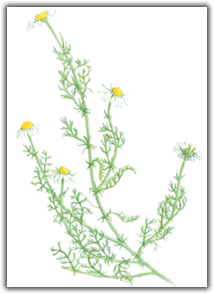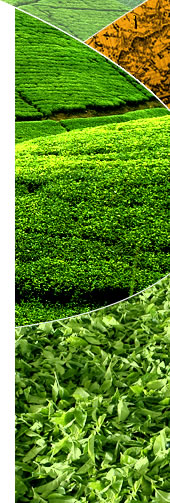| |
 |
THE CHARISMATIC CHAMOMILE
By Barry P.W. Cooper
One of the most widely consumed herb teas in the world is the ubiquitous chamomile. It can clearly be seen on many retail herb packs as an attractive daisy with startlingly white petals and bright golden center, happily towering with willowy splendor among its fellow herbal ingredients.
 Chamomile is a member of the Asteraceae family (also known as Compositae), one of the largest plant families. This family is characterized by composite flowers, hence the name Compositae. Each composite "flower" is actually an inflorescence of "flower head" consisting of many small whole flowers or florets. Each floret has all the parts of a full-sized flower; petals, stamens (the male organ) and/or pistil, the female portion which, when fertilized, produces a seed. Composites can have "disk" florets (like the center of the daisy) and/or "ray" florets, which resemble petals. Chamomile has both disk and ray florets. The stem is erect with a few narrow, finely dissected leaves. A solitary inflorescence, the flower head, tops the stem.
Chamomile is a member of the Asteraceae family (also known as Compositae), one of the largest plant families. This family is characterized by composite flowers, hence the name Compositae. Each composite "flower" is actually an inflorescence of "flower head" consisting of many small whole flowers or florets. Each floret has all the parts of a full-sized flower; petals, stamens (the male organ) and/or pistil, the female portion which, when fertilized, produces a seed. Composites can have "disk" florets (like the center of the daisy) and/or "ray" florets, which resemble petals. Chamomile has both disk and ray florets. The stem is erect with a few narrow, finely dissected leaves. A solitary inflorescence, the flower head, tops the stem.
Chamomile is an adaptable plant and will grow virtually anywhere. It is abundant in both tropical and temperate climates. It is an annual and must be planted every year, but typically self seeds. This makes it the ideal crop for the smaller farmers who allow fields to blossom into chamomile with little or no effort on their part.
Many forms of chamomile are used in the herb trade business, from whole heads through to blends of various portions of the plant that have been milled to a tea bag size.
Whole cut chamomile consists of mature plant tops that are mechanically harvested and produce a blend of disk florets and also ray florets and pieces of leaf and stem. This item is sometimes called "fine cut" or "tea bag cut" material.
Chamomile pollen is actually a misnomer, as in this case the name does not refer to the microscopic pollen released by the plants. It really refers to the small disk florets which are the center part of the composite flower. To harvest the pollen florets, the entire flower head is harvested and then the florets are separated by sifting or winnowing.
The major producing countries for chamomile have been Mexico, Argentina and Egypt. Central Europe has also been a major source in the past but has become increasingly expensive over the years.
Chamomile plants require labor intensive harvesting techniques and in Mexico and Egypt the harvest is done primarily by hand. In Argentina, some mechanized harvesting is accomplished but most of the winnowing and separation is still done by hand.
When the flowers are ripe or fully mature, the volatile oils are at their most plentiful and the resulting brew is aromatic, a rich gold color and, if one closes one's eyes, honey is the first image that comes to one's palate.
The percentage of stalk and florets also determines the price for the raw material. Different volatile oil levels produce varying degrees of aroma intensity and depth of color. Thus, similar to Camellia sinensis, there can be many blends of chamomile all designed to suit the buyers' needs. They can range from pharmaceutical grades with very high oil contents, down to pure stalk designed to do nothing more than provide weight with little flavor.
The density of chamomile has been the bane of most production facilities. The higher the percentage of disk florets and the lower the percentage of stalk, the more fluffy the product is. Putting fluffy product into small tea bags has caused many a production manager anguish as the bulky product refuses to be packed, or when packed produces a tea bag resembling a plump pillow. This problem is met by blending proportions of petals, florets, cut stalk and even, on occasion, seed to achieve the right density.
Density is not the only issue that has caused production facilities to question the ancestry of chamomile. Due to the delicate floral scent that we enjoy in the resultant cup of tea, chamomile is also very attractive to insects. Treatment for insects is thus part of a strict regime in the handling of chamomile. Cigarette Beetles, in particular, find the stuff irresistible. Other insects which appear to favor chamomile as a prime part of their diet include the Sawtooth Grain Beetle and the Drug Store Beetle. One cannot help but admire their taste as, in the world of herbs, the chamomile reigns supreme as being one of the most attractive, tasty, supposedly efficacious and aromatic herbs available in blends in the marketplace today.
![]()

|
|